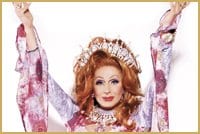It’s Friday night at the Odyssey and although it’s only a little after 10 pm, the bar is decidedly empty considering the night’s entertainment–this week’s round of the Ice Queen competition–was supposed to start a few minutes ago.
I start to wonder if Morgan Brayton was tapping into a broader sense of malaise in the gay community when she opened her Sep 14 column by declaring “I am bored of drag.”
At 10:30 pm, I still find myself sitting in front of an empty stage.
At 11:00 pm, a crowd starts to gather at the front of the still bare stage. When the night’s emcee, Iona Whipp, finally takes the stage, it’s 11:20, and the roar from the crowd is much louder than I expected.
When I turn around, I notice the club has finally gotten packed.
Vancouverites still like their drag, apparently. They’re just not early drinkers.
But it’s not that simple.
With prominent community voices complaining that drag is becoming staid, even some kings and queens are speaking out and saying that it’s time for drag to change–or that it already is changing, albeit slowly.
“I see audiences changing, but I also see the dynamics of the queens changing” as new queens take to the stage, says Willie Taylor, a fixture of the drag scene who has been donning a dress on stage for 20 years.
“Vancouver has been one of the cities that has had lots and lots of drag queens–many that are working at it and doing well at it, and lots of new ones coming up–so we’re going to be around for a while,” Taylor adds.
Drag isn’t dead, Whipp agrees, but it may be in need of renewal.
“I think the issue is seeing the same drag queens everywhere,” she says.
Despite a “whole slew” of younger queens arriving on the scene, it’s the veteran drag queens who have been around for 10 years or more hosting all the events, she says.
“I think people are tired of seeing the same things over and over again.”
“If you’re always going to the same shows, you’re not going to see new faces,” points out Olive Mee, a drag queen who’s competing in the Ice Queen competition after several years’ absence from the drag scene.
“People want to see something new they haven’t seen before,” Mee believes. “Unfortunately, drag’s not like the Mona Lisa, in that you can appreciate it for a long time. It has to be changed up.”
The Smirnoff Ice Queen competition is an annual event at the Odyssey in which up-and-coming drag kings and queens compete for a title and cash prize in a competition that’s part American Idol, part America’s Next Top Model. Ron Van Streun, general manager of the Odyssey, sees the competition as a vital launching pad for the next generation of drag performers.
“The way I keep things fresh is slowly bringing new queens into the picture,” Van Streun says. “Smirnoff Ice Queen and our Wednesday show The Faux Girls give a chance for the diamonds in the rough to show their skills.”
The fact that new drag queens and kings are performing on queer stages around town shows the scene is still thriving in Vancouver, says Sammy Tomato, who has been performing with the drag king troupe DK United for the last two years.
“There’s a newer generation,” he says. “You won’t see a lot of the old numbers done, which is a contrast between the old kings and queens, who’ll do a lot of Streisand, while we’ll do Justin Timberlake.”
Tomato says Vancouver’s drag kings partly owe their recent growth to their experiences participating in International Drag King Extravaganzas (IDKE).
“We’ve been learning a lot on the international level for the last three years, and a lot on the academia around it,” he says.
Vancouver will host next year’s ninth annual IDKE, which Tomato describes as a “drag Mecca that will bring 350 to 400 drag kings from around the world to Vancouver.” The event will feature an academic conference, open mic nights, and a drag king showcase.
Meanwhile, Whipp says her stage at the Odyssey is always open to new queens who want to give it a shot.
The reigning drag queens are welcoming to new talent, says Ada Burger, an up-and-coming queen who first performed at the Odyssey a few months ago in the Faux Girls show.
“They’re very nurturing,” says Burger. “They don’t see new queens as a threat, they see us as the next generation. They want to help us as opposed to hinder us.
“They’re not jealous of physical attributes because it doesn’t work that the audience always wants the new meat,” Burger adds.
In fact, many kings and queens point to a tradition in the drag community of “drag moms” and “drag dads.”
“A drag mom is a tenured drag queen who takes you under her wing and teaches you things,” says Mee. “Sometimes they give you their last name, so my full stage name is Olive Mee Santos, after Mae Santos.
“One time I did drag and she offered to do touch-ups and then next time she did all my makeup and taught me how,” Mee says. “But it’s not like you just walk up to a drag queen and ask, ‘can you be my drag mom?’ You have to prove yourself. Perform, be out there, show that you can be a contributor to the community.”
Tomato agrees. “I think it’s important in any performance medium to have a mentor,” he says. “I consider Devin my drag dad, because he taught me the ins and outs of it.”
Taylor, who performs with the Lips Inc troupe at the Odyssey, agrees that established drag queens are there to help out the newcomers.
“I don’t think I have a drag daughter,” he says. “I’m more of a drag aunt. If anybody needs anything I’m there to help, but I don’t have one specific person.”
For many new kings and queens, the help is greatly appreciated, as the start-up costs of doing drag can be quite expensive, with estimates ranging from a bargain-shopping $100 to a more glamorous $450.
Burger, who got her first wig and costume pieces from her drag mom, Carlotta Gurl, says getting started would be prohibitively expensive if not for the help of more established queens.
“It’s absolutely not cheap. That’s why when I started out I borrowed,” she says.
Drag parents can also offer other important tips, Burger continues. “When you’re starting out, they can tell you what stores to go to, what salespeople to talk to and what salespeople not to talk to.”
Burger, who moved downtown recently from White Rock, explains that buying your first dress or makeup kit can still be a scary experience if you don’t know who to talk to.
“I bought some lipstick in White Rock once and I got some weird looks for that,” she says. “It’s way more accepting downtown.”
Tomato disputes any suggestion that drag kings have an easier time getting into the scene because they don’t have to be as glamorous.
“I think the biggest challenge is that we are compared to drag queens when, in reality how many people actually compare Justin Timberlake to Britney Spears?” he asks.
“Performing femininity is so different from performing masculinity. Masculinity is so much more subdued, unless you’re doing Elton John. It’s more about the subtleties of masculinity or playing up the chauvinist thing to break it down.
“The problem is emulating a masculine character and not a drag queen,” he says.
But the bottom line, everyone agrees, is that to break into the scene an aspiring king or queen needs talent.
“Any kind of public speaking or theatre classes, or anything that will allow you to be more outgoing, any musical theatre, any dance classes, will make your performance that much more interesting,” says Whipp, who also co-hosts the weekly amateur Faux Girls show with Jaylene. “But the big thing is natural desire and talent. If you just love performing and can get in front of an audience with no shame, that will go much further for you than a girl who’s shy but has dance training.
“If you’re interested in a Faux Girls spot, you simply have to contact Jaylene and be booked,” she adds.
With the Odyssey featuring drag four nights each week, new performers breaking into the scene, Vancouver poised to host IDKE, and queens and kings performing regularly at the Dufferin, Numbers, Lick, and Club 23, it’s unlikely that drag is on the decline in this city.
“Drag is part of our gay tapestry,” Van Streun says. “Drag queens are the spice of gay life, going back to the medieval ages.”


 Why you can trust Xtra
Why you can trust Xtra


